
Trihexyphenidyl hydrochloride for Parkinson’s disease
What is trihexyphenidyl hydrochloride for Parkinson’s disease?
Trihexyphenidyl hydrochloride is an oral therapy approved to help manage symptoms of Parkinson’s disease, and often used as an add-on to levodopa treatment.
The medication originally was marketed by Lederle under the brand name Artane. However, the approval of this brand-name therapy was withdrawn in 2012 at the company’s request, as the product was no longer being marketed. Several generic versions are still available.
Trihexyphenidyl hydrochloride also can be used to prevent or treat muscular conditions similar to Parkinson’s that are caused by certain antipsychotic therapies.
Therapy snapshot
| Brand name: | Available as a generic medication only |
| Chemical name: | Trihexyphenidyl hydrochloride |
| Usage: | Used as an add-on to manage all forms of parkinsonism and treat movement disorders that occur as a side effect of antipsychotic therapy |
| Administration: | Oral tablets or elixir |
How does trihexyphenidyl hydrochloride work?
The exact mechanisms of how trihexyphenidyl works in Parkinson’s disease are incompletely understood, but the therapy is believed to act as an anticholinergic — meaning it blocks the activity of a neurotransmitter called acetylcholine.
Neurotransmitters are signaling chemicals that nerve cells use to communicate with each other and the rest of the body. Parkinson’s disease is caused by the death and degeneration of brain cells responsible for making a neurotransmitter called dopamine.
Normally, dopamine and acetylcholine work in tandem to help regulate movements. But in Parkinson’s, there is less dopamine available, which throws off the balance between these two neurotransmitters. It’s thought that trihexyphenidyl and other anticholinergics that reduce acetylcholine signaling work to ease Parkinson’s symptoms by helping to restore this balance.
Who can take trihexyphenidyl hydrochloride?
Trihexyphenidyl was approved by the U.S. Food and Drug Administration (FDA) as a treatment for Parkinson’s disease in May 1949.
The medication is indicated for the treatment of all forms of parkinsonism. This includes Parkinson’s disease and other conditions marked by Parkinson’s-like motor symptoms, such as slowed movements, tremor, and rigidity.
It’s often used as an add-on to levodopa-based medications.
Who should not take trihexyphenidyl hydrochloride?
Trihexyphenidyl is contraindicated, or not recommended, for anyone with:
- an allergy to the medication or any of its ingredients
- narrow-angle glaucoma, a type of eye disease.
For those with narrow-angle glaucoma, the medication can worsen the condition and cause blindness.
How is trihexyphenidyl hydrochloride administered?
Trihexyphenidyl is available as a tablet and as a elixir formulation, both of which are taken by mouth. Tablets exist at dosage strengths of 2 or 5 mg, while the elixir has a concentration of 2 mg trihexyphenidyl per every 5 mL of liquid.
The recommended starting dose of trihexyphenidyl in people with Parkinson’s is 1 mg/day. This can then be increased by 2 mg every three to five days, up to a total dose of around 6 to 10 mg/day, based on what the patient tolerates and how well the treatment controls symptoms. In some patients, doses up to 12 to 15 mg/day may be needed to fully manage symptoms.
When concurrently administering both levodopa and trihexyphenidyl, it may be necessary to reduce the usual dose of both treatments. Typically, effective symptom management with minimal side effects involves a daily trihexyphenidyl dosage of 3 to 6 mg, administered in divided doses.
Abrupt discontinuation of trihexyphenidyl should be avoided as it can result in worsening of symptoms.

Trihexyphenidyl hydrochloride in clinical trials
The first study testing trihexyphenidyl in people with Parkinson’s disease was published in 1949. In that study, 117 patients, ages 25-78, received the therapy at starting doses of 1-2.5 mg given two to three times a day, and could adjust their dosage based on their clinical response.
Participants were assessed to see whether they reported any lessening in the severity of Parkinson’s symptoms. Results showed more than three-quarters (76.1%) reported at least some improvement.
A second study, also published in 1949, tested the drug in 69 Parkinson’s patients, ages 12 to 78. More than three-quarters of the participants (77%) reported an improvement after treatment with trihexyphenidyl.
In another study published in 1954, 411 Parkinson’s patients were treated with trihexyphenidyl for up to five years. Doses of the medication in individuals with all forms of parkinsonism ranged from 2 to 30 mg, with dosages of 6-10 mg used for idiopathic Parkinson’s patients, or those whose condition was due to unknown causes. The treatment helped to ease symptoms for 73% of the patients, the results indicated.
In the decades since that first study, other studies have consistently indicated that trihexyphenidyl can be helpful for managing Parkinson’s symptoms, especially in younger patients who are mainly bothered by tremor.
Common side effects of trihexyphenidyl hydrochloride
The most common side effects of trihexyphenidyl include:
- dry mouth
- blurry vision
- mild nausea
- nervousness
- dizziness.
Monitoring
Patients should undergo an eye exam called gonioscopy prior to starting treatment with trihexyphenidyl. In individuals taking the medicine, intraocular pressure — the pressure inside the eyeballs — should be measured routinely.
Although trihexyphenidyl hydrochloride is not contraindicated in people with disorders of the liver, kidneys, or heart, caution should be used in these situations; close monitoring of patients is recommended. Cautious use and monitoring also is recommended for people with diseases that obstruct the intestines or urinary system, glaucoma, or abnormal prostate growth. Patients with high blood pressure also should have their blood pressure monitored while on the therapy.
With long-term use, all patients on trihexyphenidyl should undergo careful monitoring for potential allergic reactions and other unwanted effects.
Behavioral changes and co-occurring health conditions
People with arteriosclerosis, a medical condition characterized by the accumulation of fatty deposits on the walls of arteries, or with a history of unusual reactions to other drugs may experience mental confusion, agitation, disturbed behavior, or nausea and vomiting when treated with trihexyphenidyl.
To minimize these reactions, such patients should start treatment with a small dose and gradually increase it until an effective level is reached. If a severe reaction occurs, trihexyphenidyl should be stopped for a few days before resuming at a lower dosage. Indiscriminate use, especially leading to overdosage, can result in psychiatric disturbances and sustained euphoria (feelings of intense happiness, excitement, or joy).
Use in pregnancy and breastfeeding
Trihexyphenidyl is able to cross the placenta to a developing fetus during pregnancy. Studies have not suggested an increased risk of major congenital disabilities when anticholinergic drugs like trihexyphenidyl are taken during pregnancy. However, miscarriages and molar pregnancies — a type of tumor that arises in the uterus due to a nonviable pregnancy — have been reported in pregnant patients taking these types of drugs, so they should be used with caution during pregnancy.
Prolonged use of trihexyphenidyl can cause a reduction in breast milk production. Lactating patients should be monitored for signs of decreased milk production if taking the therapy long term.
Parkinson’s News Today is strictly a news and information website about the disease. It does not provide medical advice, diagnosis or treatment. This content is not intended to be a substitute for professional medical advice, diagnosis, or treatment. Always seek the advice of your physician or another qualified health provider with any questions you may have regarding a medical condition. Never disregard professional medical advice or delay in seeking it because of something you have read on this website.
Recent Posts
Related articles
 Fact-checked by
Fact-checked by 



